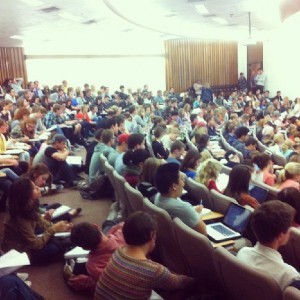
Class size can affect the way students perform academically, according to at least one research study.
Classes at BYU range from less than 20 students up to 860 students. American Heritage, Accounting 200, Biology 100 and Business Management 241 are classes that each have 200 students or more.
“I think some of the classes are way too big,” BYU student Whitney DeMille said. “I just fall asleep in huge classes. I’m just not as engaged as I am in smaller classes.”
J.J. Arias and Douglas M. Walker, professors at Georgia College and State University who research economic education, conducted a study in 2004 on the relationship between class size and student performance. Georgia College and State University offered multiple classes of the same course with the same professor and same materials. The only difference was the size of the class.
Results showed that students in the smaller classes scored at least three percent better on the final exam than students in the larger classes.
BYU students have certain required courses, and some of these are held in classes of 200 students or more to accommodate the large number of students that need to take the courses.
Melissa Larson teaches Accounting 200 and Accounting 403, which is part of the junior core classes in the business management major at BYU. She has just under 1,400 students enrolled in Accounting 200: 600 students in the morning class and 800 in the afternoon.
Her Accounting 403 class, however, has only 55 students. Larson said she enjoys teaching both large and small classes, but for different reasons.
“I love the energy of the bigger classes,” Larson said. “With the interaction and the students in groups, there’s a high level of energy in there. It’s a lot of fun.”

Larson said she enjoys teaching small classes and getting to know the students’ names. She finds more of a connection with those in the smaller classes.
“The worst thing about the large classes is that I don’t have a student connection. It’s almost a superficial connection with the students,” Larson said. “I love all of them, but I don’t know them individually.”
BYU student Wesley Monahan, a junior in commercial music, agrees with Larson. He said he tends to get better grades in smaller classes.
“Teachers in smaller classes understand where you have been and how far you have come,” Monahan said. “I think they’re willing to help you more.”
Monahan and DeMille both believe the ideal class size is 20 students. “I think 20 is a large enough group to have discussion, but small enough to share opinions and participate,” DeMille said.
Monahan said small classes are better at getting all the students involved. “Your questions get answered and your comments are heard,” he said.
Larson said larger classes can be difficult. “It’s crazy,” she said. “I go to the copy center and ask for 1,400 copies (of class material).”
To better accommodate her students, Larson has provided them with sources to make the class more engaging.
“I brought in I-Clickers because it is more interactive,” Larson said. “I ask a question, they get in groups and work on it. I think the class likes seeing the results of the answers and having some way to interact.”
Larson also has five TAs. She has a handout for every class period that outlines what they will do during class and has problems for students to work on. Larson also sends out a weekly email of tips and reminders because she can’t meet with every student. It’s a way for her to connect with her students, even when there are 1,400 of them.




